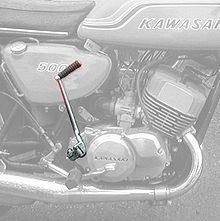Kickstarter

A kick starter is a foot-operated starting device for motorized two-wheelers . The strong kick of the driver on the kick starter accelerates the crankshaft to the speed required to start. Most motorcycles built up to around 1970 were started with a kick starter, then electric starters became more popular, although they had already existed before.
Structure and functionality
It is a (mostly foldable) lever with a pedal or a step bar on the outside of the motor, which in principle works like a pedal crank , but with a limited range of rotation (a maximum of a semi-circular movement of 180 °). The movement is transmitted to the crankshaft (primary kick starter) or to the transmission countershaft (secondary kick starter) by means of a gear transmission in the motor housing . Some motorcycles with a longitudinal crankshaft have a kick starter lever that requires pedaling across the vehicle's longitudinal axis.
A ratchet freewheel is located between the kick starter shaft and the gear or crankshaft , on the one hand to bring the crankshaft to a suitable starting position ( dead center search) by briefly actuating it before the actual start step , on the other hand to allow the starting engine to rev up freely. In most cases, the entire mechanism is completely disengaged by a control link in the upper rest position and mechanically completely decoupled (in both directions of rotation) from the rotating gear shafts; With many four-stroke machines, this is also the case at the lower end of the actuation path, in order to protect the user from injuries caused by a possibly "kicking back" motor (change of direction of rotation, brief backward movement against the actual direction of rotation) during the first work cycles.
Startup process
Depending on the ergonomics, the kick starter is usually operated with the right foot while standing to the left of the motorcycle (kick starter on the left side of the engine) or sitting on or standing above the motorcycle (kick starter on the right side).
Since the engine is only rotated a few times or even only once (with larger single - cylinder four-stroke engines ) through the ignition dead center due to the limited, achievable angle of rotation , it is important to follow the start procedure specified by the manufacturer (often these are points such as safe standing, folding the front passenger footrest , actuation of cold start aids such as swab or choke , if necessary warm start lever or button, suction without ignition, correct position of the crankshaft, actuation of the decompression lever or activation of the automatic valve lifter, switch on the ignition, gas position) before the actual start step in order to maintain a to achieve a reliable start with as few attempts as possible. The kick should not be carried out half-heartedly, especially with larger-volume engines, but consistently with noticeable use of force over the entire path of the starter to the end position in order to achieve sufficient speed and momentum and to counteract any kickback of the engine and the associated risk of injury. After the engine has ignited and has safely run a few revolutions, the starter is slowly brought back up and folded in.
Mokick
From mopeds to end developed in the 1950s, the moped who possessed instead of the bicycle-type pedal cranks with pedals on footrests and Kickstarter. The first Mokick was the Jawa 50, on which the Kickstarter was used from 1956.
In the case of the very popular small scooters, the kick starter is a useful fallback option, despite the fact that electric starters are usually present , as these vehicles cannot be started even temporarily by simply pushing them if the electric starter is defective (e.g. due to an empty battery) , because the power transmission is via a centrifugal clutch and belt drive only has a positive connection to the rear wheel when the engine is running.
Other names
In the technical documentation, kick starters are also referred to as starter levers; in the German DIN standards , the word “starter lever” was also used.
Different definition in the standardization
In the DIN EN 16029 standard, motorized (ride-on) vehicles without approval for public road traffic, intended for the transport of people - Single-track two-wheeled vehicles - Safety requirements and test methods; German version EN 16029 2012, edition 2012: 08 , the Kickstarter is defined, deviating from the Wikipedia definition, as "hand or foot operated device to put the vehicle into operation".
Web links
- Exploded view of the Kickstarter Mechanism on a Yamaha SR500 , accessed June 6, 2016
literature
- Peter A. Wellers, Hermann Strobel, Erich Auch-Schwelk: Vehicle technology expertise. 5th edition, Holland + Josenhans Verlag, Stuttgart 1997, ISBN 3-7782-3520-6 .